
George Montagu was an English army officer and naturalist. He was known for his pioneering Ornithological Dictionary of 1802, which for the first time accurately defined the status of Britain's birds. He is remembered today for species such as the Montagu's harrier, named after him.

Rhagonycha is a genus of soldier beetle belonging to the family Cantharidae. There are at least 140 described species recorded from Europe, North America and Japan, and thought to date from the Upper Eocene to recent periods.

Giuseppe Saverio Poli was an Italian physicist, biologist and natural historian.
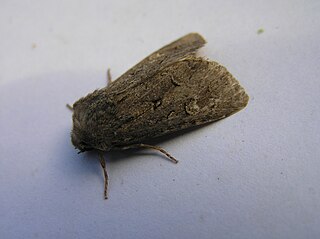
Luperina testacea, the flounced rustic, is a moth of the family Noctuidae. It is found in Europe, Asia Minor and Armenia.
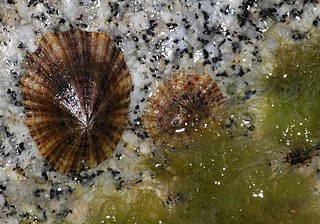
Patella caerulea, is a species of limpet in the family Patellidae. It is known by the common names Mediterranean limpet and rayed Mediterranean limpet. It is native to the Mediterranean Sea.
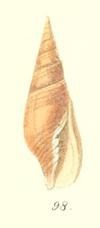
Strigatella testacea is a species of sea snail, a marine gastropod mollusk in the family Mitridae, the miters or miter snails.

Agaronia testacea, a species of sea snail with the common name Panama false olive, is a marine gastropod mollusk in the family Olividae, which are known collectively as "the olives".

Angonyx testacea, the northern dark-green hawkmoth, is a moth of the family Sphingidae.
Psyrassa is a genus of beetles in the family Cerambycidae, containing the following species:
Egalicia is a genus of longhorn beetles of the subfamily Lamiinae, containing the following species:

Cryptopone testacea, is a species of ant of the subfamily Ponerinae.
Egalicia flavescens is a species of beetle in the family Cerambycidae. It was described by Thomson in 1864. It is known from Brazil.
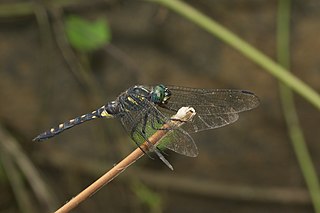
Onychothemis testacea, the stellate river hawk, or riverhawker, is a species of dragonfly in the family Libellulidae. It is widespread in many Asian countries.

Caladenia testacea, commonly known as honey caps, or honey caladenia is a plant in the orchid family Orchidaceae and is endemic to New South Wales. It is a ground orchid with a single, sparsely hairy leaf and up to three white to yellowish-green flowers with brownish tips and a darker back.
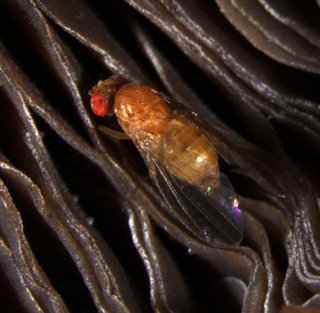
Drosophila neotestacea is a member of the testacea species group of Drosophila. Testacea species are specialist fruit flies that breed on the fruiting bodies of mushrooms. These flies will choose to breed on psychoactive mushrooms such as the Fly Agaric Amanita muscaria. Drosophila neotestacea can be found in temperate regions of North America, ranging from the north eastern United States to western Canada.

Drosophila testacea is a member of the testacea species group of Drosophila. Testacea species are specialist fruit flies that breed on the fruiting bodies of mushrooms. Drosophila testacea can be found in temperate regions of Europe, extending to East Asia. Drosophila testacea and Drosophila orientacea can produce viable hybrids, though they are separated by geography and behavioural barriers. Drosophila testacea females will also readily mate with Drosophila neotestacea males, but viable hybrids are never produced. This hybrid inviability ) may be due to selfish X chromosomes and co-evolved suppressors. Alternately, differences in sex pheromone reception could underlie female readiness and male willingness to copulate.
Drosophila orientacea is a member of the testacea species group of Drosophila. Testacea species are specialist fruit flies that breed on the fruiting bodies of mushrooms. Drosophila orientacea is found in northern Japan on the island of Hokkaido. However, the European species Drosophila testacea and D. orientacea can produce viable hybrids, blurring the level of speciation between the two species. While viable hybrids are produced, extreme behavioural barriers likely prevent mating in the wild. While D. orientacea readily mates with Drosophila neotestacea, viable hybrids are never produced. This hybrid inviability may be due either to issues during copulation, or selfish X chromosomes and co-evolved suppressors.

The Drosophila testacea species group belongs to the Immigrans-tripunctata radiation of the subgenus Drosophila, and contains 4 species: Drosophila putrida, Drosophila neotestacea, Drosophila testacea, and Drosophila orientacea. Testacea species are specialist mushroom-feeding flies, and can metabolize toxic compounds in Amanita mushrooms. The Testacea species group is studied for its specialist ecology, population genetics, and bacterial endosymbionts. The North American species Drosophila neotestacea is perhaps the best-studied of the group for its interactions with parasitic wasps and nematodes, bacterial endosymbionts, and trypanosomatid parasites. Of note, selfish X chromosomes have been discovered in three of the four Testacea group species.

Mushroom-feeding Drosophila are a subset of Drosophila flies that have highly specific mushroom-breeding ecologies. Often these flies can tolerate toxic compounds from Amanita mushrooms.














